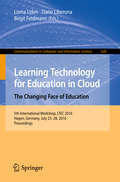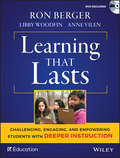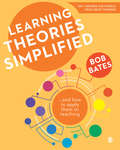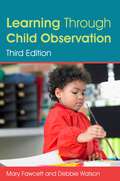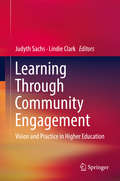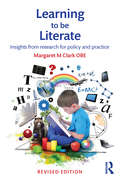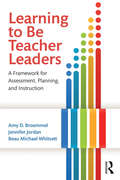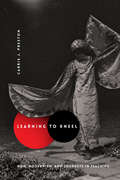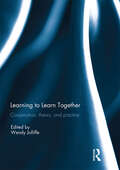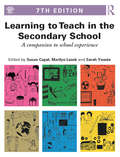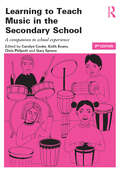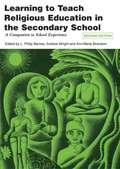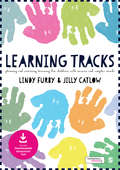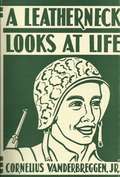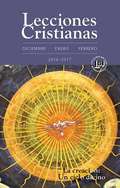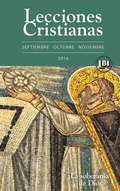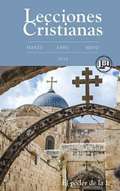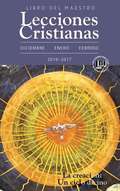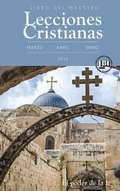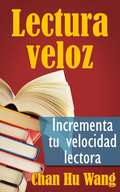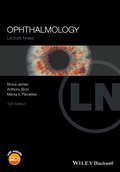- Table View
- List View
Learning Technology for Education in Cloud - The Changing Face of Education
by Lorna Uden Dario Liberona Birgit FeldmannThis book constitutes the refereed proceedings of the 5th International Workshop on Learning Technology for Education in Cloud, LTEC 2016, held in Maribor, Slovenia, in July 2016. The 25 revised full papers presented were carefully reviewed and selected from 51 submissions. The papers are organized in topical sections on learning technologies; learning tools and environment; MOOC for learning; problem solving and knowledge transfer; case study.
Learning That Lasts: Challenging, Engaging, and Empowering Students with Deeper Instruction
by Jal Mehta Ron Berger Libby Woodfin Anne VilenA practical guide to deeper instruction--a framework for challenging, engaging, and empowering students of all ages For schools to meet ambitious new standards and prepare all students for college, careers, and life, research has shown unequivocally that nothing is more important that the quality of daily instruction. Learning That Lasts presents a new vision for classroom instruction that sharpens and deepens the quality of lessons in all subject areas. It is the opposite of a 'teacher-proof' solution. Instead, it is predicated on a model of instruction that honors teachers as creative and expert planners of learning experiences for their students and who wish to continuously grow in their instructional and content knowledge. It is not a theoretical vision. It is a model of instruction refined in some of the nation's most successful public schools--schools that are beating the odds to create remarkable achievement--sited primarily in urban and rural low-income communities. Using case studies and examples of powerful learning at all grade levels and in all disciplines, Learning That Lasts is a guide to creating classrooms that promote deeper understanding, higher order thinking, and student independence. Through text and companion videos, readers will enter inspiring classrooms where students go beyond basics to become innovators, collaborators, and creators. Learning That Lasts embraces a three-dimensional view of student achievement that includes mastery of knowledge and skills, character, and high-quality work. It is a guide for teachers who wish to make learning more meaningful, memorable, and connected to life, and inspire students to do more than they think possible.
Learning Theories Simplified: ...and how to apply them to teaching
by Dr Bob BatesAre you struggling to get your head around John Dewey's educational pragmatism? What exactly is Jean Piaget saying about cognitive development? Maybe you're running out of time and patience making sense of Carol Dweck's mindsets? Have you reached breaking point reading Daniel T. Willingham on educational neuroscience? Written for busy teachers, trainers, managers and students, this dip-in dip-out guide makes theories of learning accessible and practical. It explores over 100 classic and contemporary learning theorists in an easy-to-use, bite-sized format with clear relevant illustrations on how each theory will benefit your teaching and learning. Each model or theory is explained in less than 350 words, many with accompanying diagrams, and the 'how to use it' sections, in less than 500 words. Every entry includes: Do it steps in order to apply the theory or model Reflection points & challenges to develop your understanding of how to apply it Analogies & metaphors from which understanding and meaning can be drawn Tips for the classroom Further reading if you want to explore a theory in greater depth.
Learning Theories Simplified: ...and how to apply them to teaching
by Dr Bob BatesAre you struggling to get your head around John Dewey’s educational pragmatism? What exactly is Jean Piaget saying about cognitive development? Maybe you’re running out of time and patience making sense of Carol Dweck’s mindsets? Have you reached breaking point reading Daniel T. Willingham on educational neuroscience? Written for busy teachers, trainers, managers and students, this dip-in dip-out guide makes theories of learning accessible and practical. It explores over 100 classic and contemporary learning theorists in an easy-to-use, bite-sized format with clear relevant illustrations on how each theory will benefit your teaching and learning. Each model or theory is explained in less than 350 words, many with accompanying diagrams, and the ‘how to use it’ sections, in less than 500 words. Every entry includes: Do it steps in order to apply the theory or model Reflection points & challenges to develop your understanding of how to apply it Analogies & metaphors from which understanding and meaning can be drawn Tips for the classroom Further reading if you want to explore a theory in greater depth. More titles by Bob Bates: Educational Leadership Simplified A Quick Guide to Special Needs and Disabilities
Learning Through Child Observation, Third Edition
by Debbie Watson Mary FawcettThis fully updated third edition of Learning Through Child Observation is a handbook for professionals working in, or students preparing to work in, children's services. This accessible text examines the value of observation, its use in assessment and the practical aspects and methods of observational study. The authors focus on the importance of fully recognising the child's developmental and emotional state when intervening, and the need to see children 'holistically' and as unique individuals within the wider context of the family and community. This new edition reflects updates to policy and practice and further develops the critical perspective on contemporary thinking about childhood and observational methods. This edition has also expanded its focus to include observation of primary-aged children. A popular text, it will appeal to students and professionals in all children's services, whether in pre-school, schools, social care, mental health or health settings.
Learning Through Community Engagement
by Judyth Sachs Lindie ClarkThis book charts the development of a whole-institution approach to university-community engagement at a modern Australian university, highlighting the pivotal role that curriculum renewal can play in organizational transformation. It describes how Macquarie University's PACE (Professional and Community Engagement) program developed and fostered a culture of learning that has been at the center of academic renewal, differentiation, and institutional change. It details the development of the PACE pedagogical model, the establishment of the network of stakeholder relationships which underpin it, and the embedding of the model across the whole institution. Authored by those directly involved in the change project, this book tells the story of PACE, its achievements, challenges, success factors and future directions. A series of dovetailing contributions by leading international scholars of university-community engagement set the PACE story in its global context. This book adds to the scholarship of learning through community engagement, provides international perspectives on trends and issues in university-community engagement, contributes to a broader understanding of the practice and pedagogy of community engagement, and discusses the challenges and opportunities of implementing and sustaining change in the higher education sector.
Learning to be Literate: Insights from research for policy and practice
by Margaret M ClarkWinner of the prestigious UK Literacy Association Academic Book Award for 2015 in its original edition, this fully revised edition of Learning to be Literate uniquely analyses research into literacy from the 1960s through to 2015 with some surprising conclusions. Margaret Clark explores the argument that young children growing up in a literate environment are forming hypotheses about the print around them, including environmental print, television, computer games and mobile phones. In a class where no child can yet read there is a wide range of understanding with regards to concepts of print and the critical features of written language. While to any literate adult, the relationship between spoken and written language may be obvious, young children have to be helped to discover it. This persuasive argument demonstrates the value of research in order to make informed policy decisions about children’s literacy development. Accessible and succinct, Professor Clark’s writing brings into sharp focus the processes involved in becoming literate. The effect on practice of many recent government policies she claims run counter to these insights. The key five thematic sections are backed up with case studies throughout and include: Insights from Literacy Research: 1960s to 1980s Young Literacy Learners: how we can help them Curriculum Developments and Literacy Policies, 1988 to 1997: a comparison between England and Scotland Synthetic Phonics and Literacy Learning: government policy in England 2006 to 2015 Interpretations of Literacy in the Twenty-first Century
Learning to Be Teacher Leaders: A Framework for Assessment, Planning, and Instruction
by Jennifer Jordan Amy D. Broemmel Beau Michael WhitsettLearning to Be Teacher Leaders examines three integrated components of strong pedagogy—assessment, planning, and instruction—within a framework emphasizing the knowledge, skills, and dispositions that can empower teachers to become teacher leaders within their schools. Combining the what, why, and how of teaching, the research-based concepts, presented in a pragmatic format, are relevant across grade levels, classrooms, and content areas. Designed to support success on national licensure assessments, this text brings together in one place the important features of learning to be an effective teacher, and becoming a teacher leader who continues to grow and develop within the profession. Taking a student-centered approach to instruction, it also recognizes the outside factors that can challenge this approach and provides strategies for coping with them. Using this book as a guide and resource, pre-service and beginning teachers will focus on the most important factors in teaching, resulting in strengthening their pedagogy and developing a language that helps them move forward in terms of agency and advocacy. A Companion Website provides additional resources for instructors and students.
Learning to Kneel: Noh, Modernism, and Journeys in Teaching (Modernist Latitudes)
by Carrie J. PrestonIn this inventive mix of criticism, scholarship, and personal reflection, Carrie J. Preston explores the nature of cross-cultural teaching, learning, and performance. Throughout the twentieth century, Japanese noh was a major creative catalyst for American and European writers, dancers, and composers. The noh theater’s stylized choreography, poetic chant, spectacular costumes and masks, and engagement with history inspired Western artists as they reimagined new approaches to tradition and form. In Learning to Kneel, Preston locates noh’s important influence on such canonical figures as Pound, Yeats, Brecht, Britten, and Beckett. These writers learned about noh from an international cast of collaborators, and Preston traces the ways in which Japanese and Western artists influenced one another.Preston’s critical work was profoundly shaped by her own training in noh performance technique under a professional actor in Tokyo, who taught her to kneel, bow, chant, and submit to the teachings of a conservative tradition. This encounter challenged Preston’s assumptions about effective teaching, particularly her inclinations to emphasize Western ideas of innovation and subversion and to overlook the complex ranges of agency experienced by teachers and students. It also inspired new perspectives regarding the generative relationship between Western writers and Japanese performers. Pound, Yeats, Brecht, and others are often criticized for their orientalist tendencies and misappropriation of noh, but Preston’s analysis and her journey reflect a more nuanced understanding of cultural exchange.
Learning to Kneel: Noh, Modernism, and Journeys in Teaching (Modernist Latitudes)
by Carrie J. PrestonIn this inventive mix of criticism, scholarship, and personal reflection, Carrie J. Preston explores the nature of cross-cultural teaching, learning, and performance. Throughout the twentieth century, Japanese noh was a major creative catalyst for American and European writers, dancers, and composers. The noh theater's stylized choreography, poetic chant, spectacular costumes and masks, and engagement with history inspired Western artists as they reimagined new approaches to tradition and form. In Learning to Kneel, Preston locates noh's important influence on such canonical figures as Pound, Yeats, Brecht, Britten, and Beckett. These writers learned about noh from an international cast of collaborators, and Preston traces the ways in which Japanese and Western artists influenced one another. Preston's critical work was profoundly shaped by her own training in noh performance technique under a professional actor in Tokyo, who taught her to kneel, bow, chant, and submit to the teachings of a conservative tradition. This encounter challenged Preston's assumptions about effective teaching, particularly her inclinations to emphasize Western ideas of innovation and subversion and to overlook the complex ranges of agency experienced by teachers and students. It also inspired new perspectives regarding the generative relationship between Western writers and Japanese performers. Pound, Yeats, Brecht, and others are often criticized for their orientalist tendencies and misappropriation of noh, but Preston's analysis and her journey reflect a more nuanced understanding of cultural exchange.
Learning to Learn together: Cooperation, theory, and practice
by Wendy JolliffeThis book brings together a range of international studies to support the implementation of cooperative group work in the classroom. In spite of extensive research into the benefits of this approach, in many countries, it is not widely used, largely due to a lack of understanding of how to put this into practice in the classroom. Starting from an exploration of the theoretical perspectives that underpin this pedagogy, the challenges for including pupils with special educational needs and related status issues of pupils are explored. Amongst the themes explored are how creative approaches, such as Storyline, support engagement particularly for second language learning; how working with young children using cooperative group work can develop writing skills; and how teachers can work together in an effective, collaborative, and sustained manner in a professional learning community. The final chapter provides a vivid example of one teacher’s personal journal to develop her understanding of the power of cooperation in creating bridges to meaningful learning for all learners. This book was originally published as a special issue of Education 3-13.
Learning to Teach in the Secondary School: A companion to school experience
by Susan Capel Marilyn Leask Sarah YounieLearning to teach involves hard work and careful preparation. To become an effective teacher requires pedagogical and subject knowledge, an understanding of your pupils and how they learn, and the confidence to respond to dynamic classroom situations.Learning to Teach in the Secondary School is the market leading text for all undergraduate, postgraduate and school-based routes to qualified teacher status. It offers an in-depth and practical introduction to the knowledge, skills and understanding needed to become a confident and effective teacher. With a focus on evidence-based practice, the book includes a wealth of examples to demonstrate how to successfully apply theory to practice, and how to critically analyse your practice to maximise pupil learning.This 7th edition is fully updated in light of the latest initiatives, evidence and research in the field, offering comprehensive coverage, unit by unit, of the key concepts and skills addressed on initial teacher education courses in preparation for work in schools. The wide range of pedagogical features support both university based work - including that up to Masters Level - and school-based initial teacher education, and are designed to help you develop those qualities that lead to good practice and a successful future in education. Written by expert practitioners, thirty-six essential units include: •??????? adopting a positive approach to managing behaviour to support learning •??????? ways pupils learn •??????? planning lessons, units of work and schemes of work •??????? motivating pupils •??????? assessment •??????? inclusion and special educational needs •??????? using ICT and digital technologies •??????? pupil grouping, progression and differentiation •??????? managing time, workload and stress •??????? getting your first teaching post. Learning to Teach in the Secondary School provides practical help and guidance for many of the situations and potential challenges you are faced with in school. Supported by the Learning to Teach Subjects in the Secondary School Series, it is an essential purchase for every aspiring secondary school teacher.
Learning to Teach Music in the Secondary School: A companion to school experience (Learning to Teach Subjects in the Secondary School Series)
by Carolyn Cooke, Keith Evans, Chris Philpott and Gary SpruceThis 3rd edition of Learning to Teach Music in the Secondary School has been thoroughly revised to take account of the latest initiatives, research and scholarship in the field of music education, and the most recent changes to the curriculum. By focusing on overarching principles, it aims to develop reflective practitioners who will creatively and critically examine their own and others’ ideas about music education, and the ways in which children learn music.Providing an overview of contemporary issues in music teaching and learning from a range of perspectives, the book focuses on teaching music musically, and enables the reader to: place music education in its historical and social context consider the nature of musical knowledge and how teachers can facilitate their students to learn musically critically analyse the frameworks within which music teachers work develop an understanding of composing, performing and responding to music, as well as key issues such as creativity, individual needs and assessment examine aspects of music beyond the classroom and how effective links can be made between curriculum music and music outside of school. Including a range of case studies, tasks and reflections to help student teachers integrate the theory and practice of music education effectively, this new edition will provide invaluable support, guidance and challenges for teachers at all stages of their careers, as well as being a useful resource for teacher educators in a wide range of settings.
Learning to Teach Religious Education in the Secondary School: A Companion to School Experience
by L. Philip Barnes Andrew Wright Ann-Marie BrandomLearning to Teach Religious Education in the Secondary School provides insights from current educational theory and the best contemporary classroom teaching and learning, and suggests tasks, activities and further reading that are designed to enhance the quality of initial school experience for the student teacher. Key themes addressed include: the place of Religious Education in the curriculum state and faith community schooling developing schemes of work language and religious literacy teaching religion at 16 plus religion and moral education collective worship. This second edition has been thoroughly updated throughout to take account of changes to policy and the curriculum. It includes two additional chapters on ‘Religious Education and Citizenship’ and ‘Teaching Religious Education at A level’, as well as new versions of three original chapters ‘Teaching Children with Special Educational Needs’, ‘Religious Education and Moral Education’ and ‘Resources for Religious Education’. Supporting teachers in developing levels of religious and theological literacy, both of individual pupils and the society as a whole, this comprehensive and accessible text will give practising teachers and students an introduction to the craft of teaching Religious Education in the secondary school.
Learning Tracks: Planning and Assessing Learning for Children with Severe and Complex Needs
by Jilly Catlow Lindy FurbyLearning Tracks is a planning and tracking resource to support the planning and assessment of learning for children and young people with severe and complex learning disabilities. It was designed by the authors whilst teaching at a school for children and young people with severe and complex learning disabilities. This easy to use method is ready to implement in any setting to help assess children at the lowest levels of learning. It gives you, in a snapshot, where to focus your efforts with a class, a group or an individual child in order to help them progress in a meaningful way. At the very early stages of learning the steps that children and young people make can be small but incredibly significant for them and those that teach them. However, it can be problematic to evidence and formally recognise these achievements and plan next steps. Learning Tracks presents a framework to recognise achievement at these early levels and plan for progression through challenge, breadth and application. The Learning Tracks framework for recognising achievement at very early levels of learning: Can help teachers understand the way their children may be learning Offers a vocabulary for describing the learning Offers a structure for planning the learning
Learning Tracks: Planning and Assessing Learning for Children with Severe and Complex Needs
by Lindy Furby Jilly CatlowLearning Tracks is an assessment tool to support the planning and assessment of learning for children and young people with severe and complex learning disabilities (SCLD). It was designed by Lindy Furby and Jilly Catlow while teaching at St Crispin’s School for children and young people with severe and complex learning disabilities. At the very early stages of learning, the steps that children and young people make can be small but incredibly significant for them and those who teach them. However, it can be problematic to evidence and formally recognise these achievements and plan next steps. Learning Tracks presents a framework to recognise achievement at these early levels and plan for progression through challenge, breadth and application. The Learning Tracks framework for recognising achievement at very early levels of learning: Can help teachers understand the way their children may be learning Offers a vocabulary for describing the learning Offers a structure for planning the learning When you purchase Learning Tracks, you receive the book that introduces you to the framework and theories underpinning Learning Tracks, describes the curriculum included and demonstrates how it can be implemented in your setting. In addition to this book you will also receive access to the complete ready-made Learning Tracks assessment tool that can be downloaded online. This is available as a PDF with editable elements and a template you can personalise it to suit your individual needs.
A Leatherneck Looks At Life
by 2nd Lt. Cornelius Vanderbreggen Jr.The story of a WWI marine's journey to finding everlasting peace, which he finally finds in Jesus.
Lecciones Cristianas libro del alumno trimestre de invierno 2016-17/Winter 2016-17 Student Book: Un ciclo divino
by Julio GomezLecciones Cristianas tiene como propósito ayudar a las personas adultas hispanas a crecer en su comprensión de la Biblia y relación de ésta con la vida. Lecciones Cristianas sigue la serie de las Lecciones Bíblicas Internacionales. Está escrito especialmente para las iglesias de habla hispana. También hay un Libro del Maestro que provee sugerencias importantes para la enseñanza de cada lección, preguntas para discutir y actividades para la clase. Lecciones Cristianas helps Hispanic adults grow in their knowledge of the Bible and how it relates to their lives. Lecciones Cristianas follows the International Lesson Series. The content of this excellent study is biblical and it is written especially for Spanish-speaking churches. The teacher book provides valuable suggestions for teaching the class, discussion questions, and class activities.
Lecciones Cristianas libro del alumno trimestre de otoño 2016: La soberanía de Dios
by Carmen GaudLecciones Cristianas tiene como propósito ayudar a las personas adultas hispanas a crecer en su comprensión de la Biblia y relación de ésta con la vida. Lecciones Cristianas sigue la serie de las Lecciones Bíblicas Internacionales. Está escrito especialmente para las iglesias de habla hispana. También hay un Libro del Maestro que provee sugerencias importantes para la enseñanza de cada lección, preguntas para discutir y actividades para la clase. Lecciones Cristianas helps Hispanic adults grow in their knowledge of the Bible and how it relates to their lives. Lecciones Cristianas follows the International Lesson Series. The content of this excellent study is biblical and it is written especially for Spanish-speaking churches. The teacher book provides valuable suggestions for teaching the class, discussion questions, and class activities.
Lecciones Cristianas libro del alumno trimestre de primavera 2016
by Ediberto LopezLecciones Cristianas tiene como proposito ayudar a las personas adultas hispanas a crecer en su comprension de la Biblia y relacion de esta con la vida. Lecciones Cristianas sigue la serie de las Lecciones Biblicas Internacionales. Esta escrito especialmente para las iglesias de habla hispana. Tambien hay un Libro del Maestro que provee sugerencias importantes para la ensenanza de cada leccion, preguntas para discutir y actividades para la clase. Lecciones Cristianas helps Hispanic adults grow in their knowledge of the Bible and how it relates to their lives. Lecciones Cristianas follows the International Lesson Series. The content of this excellent study is biblical and it is written especially for Spanish-speaking churches. The teacher book provides valuable suggestions for teaching the class, discussion questions, and class activities.
Lecciones Cristianas libro del maestro trimestre de invierno 2016-17/Winter 2016-17 Teacher Book: Un ciclo divino
by Julio GomezLecciones Cristianas tiene como propósito ayudar a las personas adultas hispanas a crecer en su comprensión de la Biblia y relación de ésta con la vida. Lecciones Cristianas sigue la serie de las Lecciones Bíblicas Internacionales. Está escrito especialmente para las iglesias de habla hispana. También hay un Libro del Maestro que provee sugerencias importantes para la enseñanza de cada lección, preguntas para discutir y actividades para la clase. Lecciones Cristianas helps Hispanic adults grow in their knowledge of the Bible and how it relates to their lives. Lecciones Cristianas follows the International Lesson Series. The content of this excellent study is biblical and it is written especially for Spanish-speaking churches. The teacher book provides valuable suggestions for teaching the class, discussion questions, and class activities.
Lecciones Cristianas libro del maestro trimestre de otoño 2016: La soberanía de Dios
by Carmen GaudLecciones Cristianas tiene como propósito ayudar a las personas adultas hispanas a crecer en su comprensión de la Biblia y relación de ésta con la vida. Lecciones Cristianas sigue la serie de las Lecciones Bíblicas Internacionales. Está escrito especialmente para las iglesias de habla hispana. También hay un Libro del Maestro que provee sugerencias importantes para la enseñanza de cada lección, preguntas para discutir y actividades para la clase. Lecciones Cristianas helps Hispanic adults grow in their knowledge of the Bible and how it relates to their lives. Lecciones Cristianas follows the International Lesson Series. The content of this excellent study is biblical and it is written especially for Spanish-speaking churches. The teacher book provides valuable suggestions for teaching the class, discussion questions, and class activities.
Lecciones Cristianas libro del maestro trimestre de primavera 2016
by Pedro LópezLecciones Cristianas tiene como propósito ayudar a las personas adultas hispanas a crecer en su comprensión de la Biblia y relación de ésta con la vida. Lecciones Cristianas sigue la serie de las Lecciones Bíblicas Internacionales. Está escrito especialmente para las iglesias de habla hispana. También hay un Libro del Maestro que provee sugerencias importantes para la enseñanza de cada lección, preguntas para discutir y actividades para la clase. Lecciones Cristianas helps Hispanic adults grow in their knowledge of the Bible and how it relates to their lives. Lecciones Cristianas follows the International Lesson Series. The content of this excellent study is biblical and it is written especially for Spanish-speaking churches. The teacher book provides valuable suggestions for teaching the class, discussion questions, and class activities.
Lectura veloz: Incrementa tu velocidad lectora
by Ivette Z. Chan Hu WangAprende a leer de manera efectiva. Alcanza tu potencial de lectura para leer más y mejor que la mayoría de la gente. La lectura veloz es una habilidad que te permitirá disfrutar de los siguientes beneficios: 1. Cubrir más material escrito duplicando o triplicando el número de palabras que lees en un minuto. 2. Prestar mayor atención a la información más relevante. 3. Minimizar o eliminar las distracciones. 4. Aumentar tu concentración para mejorar tu comprensión lectora y retener más información. Aquellos que presumen de ser lectores veloces afirman tener la capacidad de leer a la increíble velocidad de 1000 a 1700 ppm, lo cual significa que pueden leer casi tres veces más rápido que un lector promedio. ¿Te gustaría alcanzar estos resultados? Cuando descuidas la lectura y la adquisición de buenos hábitos te destinas a permanecer en un nivel básico de lectura, el cual te impide obtener el máximo provecho de lo que lees. ¡Ahora es tiempo de mejorar tus habilidades de lectura! Echa un vistazo al contenido de este eBook: Capítulo 1: Antes de leer velozmente, primero LEE Capítulo 2: ¿Es difícil leer velozmente? Capítulo 3: Vicios de la lectura que te impiden ser un lector veloz Capítulo 4: Descubre tu método Capítulo 5: Mejora la eficiencia del movimiento ocular Capítulo 6: Minimiza a la voz interna Capítulo 7: Identifica velozmente la esencia de un texto ¿Estás listo para comenzar a leer velozmente? Lee más y mejor. ¡Descarga tu copia ahora!
Lecture Notes Ophthalmology
by Bruce James Bron ParulekarHighly illustrated, comprehensive, and accessible, Ophthalmology Lecture Notes is the ideal reference and revision guide to common eye problems and their diagnosis and management. Beginning with overviews of anatomy, history taking, and examination, it then covers a range of core ophthalmic conditions, including a new chapter on paediatric ophthalmology. The content has been thoroughly updated and includes: Over 200 diagrams and photographs A range of core clinical cases in chapter 20 demonstrating the clinical context of key conditions Learning objectives and summary of key points in each chapter Ophthalmology Lecture Notes is perfect for developing knowledge for clinical practice or revision in the run-up to examinations, and uses a systematic approach to provide medical students and junior doctors with all the tools they need to manage clinical situations. It is also useful for optometrists in training, helping them develop a sound understanding of clinical ophthalmology.
